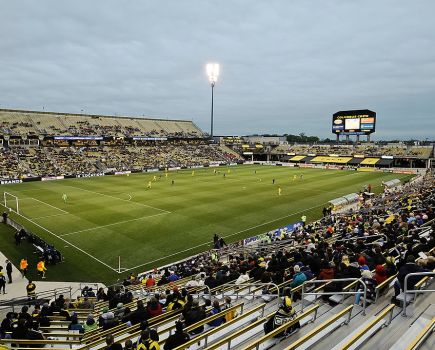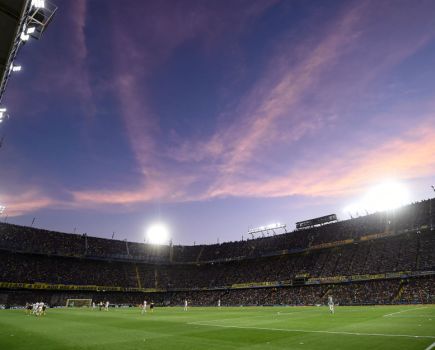Libero, the digital travel guide for football fans. Regularly refreshed with new destinations and the travelogue Soccer Sagas, Libero is a one-click treasure trove of football trip tips, tales and trivia. See www.liberoguide.com/vienna.
Ernst-Happel-Stadion, Rapid v Salzburg, Sun Oct 4, 4.30pm CET
Austria’s two leading clubs, record champions Rapid Vienna and current title-holders Red Bull Salzburg, meet for the first time this season at the national Ernst-Happel-Stadion in Vienna.
Once a powerful football hub, Austria’s capital is now more a stage for showpiece fixtures, not least the final of Euro 2008 at the Ernst-Happel, revamped for the tournament.
Recently, the traditional Viennese giants of Rapid and Austria have had to play second banana to Salzburg, sponsored by Austrian energy drink Red Bull and winners of the 2014 and 2015 titles by a country mile.
Austria’s most popular and titled club, based in the Hütteldorf district of west Vienna, in truth Rapid have been trailing in Salzburg’s shadow for far too many years. Rapid’s current title drought dates back to 2008.
Despite this lack of recent success, Rapid are investing in the future, with a €50 million stadium, the Allianz, being built on the site of their former Gerhard-Hanappi-Stadion. Work started in November 2014, with a deadline of July 2016. During that time, Rapid are playing home matches at the national Ernst-Happel.
The Grün-Weißen were founded in 1898 as the First Vienna Workers’ Football Club by employees at a local hat factory. The club quickly changed to their now familiar name after a Rapid in Berlin. Rapid have always had a workmanlike approach to the game, typified by tank-like striker Pepi Uridil of the World War I era.
Although the social divisions hardly apply today, Rapid were working-class, typified by the Rapidviertelstunde, a rhythmic hand-clapping by fans to push their team to victory over the last 15 minutes, however doomed the situation.
With pre-war star Franz ‘Bimbo’ Binder, Rapid won a dozen titles, even the German one after the Nazi-led Anschluss. Rapid continuted to dominate the Austrian game after the war, with Robert Dienst another striker to notch up more goals than appearances. Driving the team was Gerhard Hanappi, later an architect and planner of the club’s stadium that now bears his name.
Ironically, the club’s most fallow period coincided with the arrival of their most celebrated player, Hans Krankl, who returned to Rapid after a spell at Barcelona to lead Rapid in the 1980s.
After a controversial play-off victory over Celtic, Rapid reached the final of the Cup-Winners’ Cup in 1985, losing to Everton. They repeated the run, and the result, a defeat to Paris Saint-Germain, a decade later.
Since then, Rapid have only won the title twice, most recently in 2008 with the combination of young striker Erwin Hoffer and attacking midfielder Steffen Hofmann, who became the club’s figurehead and captain.
Until 2014, Rapid played at the the Gerhard-Hanappi-Stadion. Unveiled with a derby game against Austria Vienna in 1977, it was named after its architect and key post-war player.
The ground it replaced, where Hanappi, Binder and others had shone, was the Pfarrwiese, Rapid’s first proper ground after the club had played on various pitches around the west of the city. Opened in 1911, the year of the first Vienna derby, the Pfarrwiese in Hütteldorf originally held 4,000, rising to 20,000 during the Rapid’s glory days.
Modernisation proved impossible in such a tight, residential area, so Rapid had Hanappi plan the Weststadion, an all-seater of 19,000 capacity backdropped by the verdant slopes of the Wienerwald.
Named after Hanappi in 1980 following his early death from cancer, the stadium was modernised two decades later when the West- and Südtribüne were covered, lessening the effect of the strong west wind blowing down from surrounding hills.
Further improvements continued, with video screens and the excellent club museum Rapideum installed, but plans to expand and rebuild eventually came to fruition in 2014. In October, Rapid fans were invited to take their last souvenirs from their beloved ground.
When ready, the Allianz Stadion will hold 24,000.
On the ground
Host of the Euro 2008 Final that saw Spain on their path to global domination, Austria’s national stadium was built from 1928 to celebrate the tenth anniversary of the post-Habsburg Austrian republic.
Before then, the national stadium was Hohe Warte, today the 5,500-capacity, grass-terraced home of First Vienna, and modest even by Austrian second-division standards. But in 1923, it accommodated 85,000, four times more than the crowd gathered for the international with Hungary at the WAC Platz in the Prater Park three years before.
The Prater is a large green recreational space east of town by the narrow Danube. Its most famous features are the Riesenrad big wheel and funfair. The WAC, near today’s Café Meierei, was where Austria and Hungary played Europe’s first football international, on a Sunday afternoon in 1902, before 500 people.
Further along Hauptallee, near Vienna’s racecourse, the Praterstadion took two years to complete. Designed by same architect Professor Otto Ernst Schweizer who built the Frankenstadion in Nuremberg, the Prater (or Wienerstadion) was commissioned by the city’s Socialist administration. This two-tiered, 60,000-capacity amphitheatrical arena first staged a match between two local workers’ teams, then a Workers’ Olympiad. After the Anschluss with Nazi Germany, the stadium was used as a staging post for Jews being sent to concentration camps, and as a military base. Heavily bombed in the war, the Prater was quickly renovated and expanded.
With a capacity of 91,000, it was a favoured host for European finals, six in all, but fewer than 10,000 saw Manchester City beat Górnik Zabrze to win the Cup-Winners’ Cup in the rain in 1970.

Equipped with a running track and then a roof in 1985, the reduced-capacity Prater was named after legendary coach Ernst Happel after his death in 1992. A tribute friendly was played between Austria and Germany, with Happel’s cap placed on the bench.
For Euro 2008, €40 million of improvements included building a new U-Bahn station and extending the U2 line. Capacity was reduced to 53,000, an exact 51,428 for the tournament itself. The stadium also turns its hand to hosting European runs by main local clubs Rapid and Austria.
Three-tiered seating is arranged in six colour-coded sections, labelled A-F. Sectors B and E are along the touchlines, A/F and C/D behind each goal. The home end is C/D nearest Stadion U-Bahn station, away A/F.
Stadion is on the U2 line, three from the transport hub of Praterstern. Exiting to the right, you arrive at sector B and the home end to the left, the away end round the other side to the right.

Tickets are sold on the day at the Ernst-Happel-Stadion or via Rapid’s online ticket outlet.
Prices at the Ernst-Happel-Stadion start at €15 (sector A behind the goal), with €22 charged for seats in sector C and D, and €28 in sector E. The best seats (€32) are in sector B.
Children 6-14s are about a third cheaper, teenagers up to 19 a few euros cheaper. Top games against Graz, Salzburg and Austria incur a supplement of a few euros.

The classic pre-match spot is the Schweizerhaus, a large beer terrace by the green Praterturm in the Prater funfair. Themed after districts of Vienna, the Schweizerhaus can trace its history back to 1766 but owes its current guise to Karl Kolarik, who took over the business in 1920. Proffering big mugs of Budvar beer and hearty meat dishes, the Schweizerhaus is still run by the Kolarik family. The stadium is a good 15min walk through the park.
On Meiereistraße by the stadium, the Würstelstand Stadion has been in the same Teibtner family since Nat Lofthouse earned the nickname ‘The Lion of Vienna’ at an international here in 1952. Classic Balkan grilled meat dishes complement the standard sausage snacks and Ottakringer beer.
On the other side of the arena, behind sector E and by the Rapid Vienna training pitch, the Kantine Stadion is a modest hut with outdoor seating, where draught Ottakringer and bottled Stiegl beers can help wash down a Debreziner sausages or caciocavallo cheese roll. The nearby Stiegl hut offers similar on match nights.









